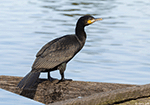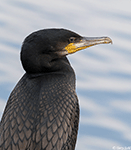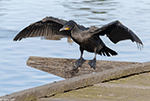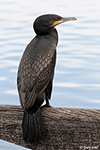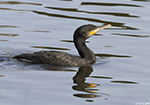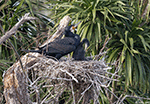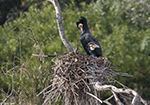Great Cormorant
Phalacrocorax carbo
| Length: 36 inches | Wingspan: 62 inches | Seasonality: Non-resident in South Dakota |
| ID Keys: Dark plumage overall, yellow chin with white throat behind it, breeding birds have conspicuous white plumage on head | ||
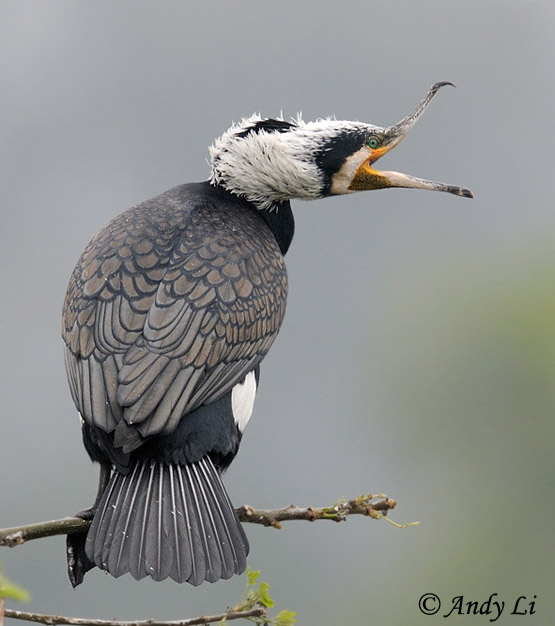 The Great Cormorant is a widespread cormorant species with populations found in
not only North America, but also in Europe, Asia, Australia, and Africa.
Until the latter half of the 20th century, Great Cormorants were very local
in the New World, with a small breeding population in select locations in
eastern Canada. In recent decades however, their populations have
greatly expanded, and breeding populations can now be found as far south as
coastal New England in the United States. They are very similar in
appearance to the Double-crested
Cormorant, a species that is widespread in North America. However,
Great Cormorants are significantly larger, have white throat and facial
markings that are lacking on Double-crested Cormorants, and also have white
feathery plumage on their heads during the breeding season (see photo to the
right).
The Great Cormorant is a widespread cormorant species with populations found in
not only North America, but also in Europe, Asia, Australia, and Africa.
Until the latter half of the 20th century, Great Cormorants were very local
in the New World, with a small breeding population in select locations in
eastern Canada. In recent decades however, their populations have
greatly expanded, and breeding populations can now be found as far south as
coastal New England in the United States. They are very similar in
appearance to the Double-crested
Cormorant, a species that is widespread in North America. However,
Great Cormorants are significantly larger, have white throat and facial
markings that are lacking on Double-crested Cormorants, and also have white
feathery plumage on their heads during the breeding season (see photo to the
right).
Habitat:
During the breeding season, Great Cormorants are found nesting on rocky cliffs. In North America, outside of the breeding season they are normally found in shallow coastal ocean waters, and are only rarely found on freshwater close to the coastline.
Diet:
Feeds mostly on fish, but may occasionally take other items such as crustaceans or marine worms.
Behavior:
Forages by swimming along the ocean's surface, diving underwater and propelling itself with its feet to capture prey.
Nesting:
The nest of a Great Cormorant is built on a cliff ledge, and is made up of seaweed, sticks and twigs, and finer grasses and vegetation for lining. The female usually lays between 3 and 5 eggs, and both parents help to incubate them. Upon hatching, both parents help tend to the young.
Song:
Great Cormorants have a grunting call given at breeding colonies, as well as a quieter, hoarser call. Away from breeding sites, they are usually silent.
- Click here to hear the grunting calls of a Great Cormorant1
- Click here to hear the flight call of a Great Cormorant2
- Click here to hear the higher-pitched begging calls of a juvenile at a nest site3
Migration:
Some birds in their North American range are evidently permanent residents, but others move well south of breeding grounds for the winter, with some reaching as far south as the coastal Carolinas (with sightings as far south as coastal Florida).
Interactive eBird Map:
Click here to access an interactive eBird map of Great Cormorant sightings
Similar Species:
Given the limited range of the Great Cormorant in North America, there's one cormorant species that is most likely to cause an identification challenge, and that's the much more cosmopolitan (in North America) Double-crested Cormorant. Another cormorant species with expanding numbers and range in North America is the Neotropic Cormorant, a species that could also conceivably be found in some of the same areas Great Cormorants are found. Three other North American Cormorant Species are found near the Pacific coast of North America and thus aren't likely to ever cross paths with a Great Cormorant (Pelagic Cormorant, Brandt's Cormorant, and Red-faced Cormorant).
- Double-crested Cormorant - Double-crested Cormorants are noticeably smaller birds than Great Cormorants, but size can be difficult to judge unless the two species are side-by-side. Structurally, Double-crested Cormorants appear to be less bulky birds, with a less bulky neck than a Great Cormorant. They also have a thinner, less robust looking bill. In terms of plumage, Double-crested cormorants share an orange gular patch with a Great Cormorant, but that patch is bordered by white in a breeding Great Cormorant. Double-crested Cormorants also lack the white flank patch that's found on a breeding-plumaged Great Cormorant.
- Neotropic Cormorant - As with the Great Cormorant, the Neotropic Cormorant is expanding its range in North America, and two birds that used to be separated by geographic distance now can conceivably both be seen in the same location. Right now that location is primarily Florida, as sightings of both species along the Atlantic Coast have been increasing in recent decades (although still rare). Neotropic Cormorants are much smaller birds than Great Cormorants, with a much thinner and less robust looking bill. Neotropic Cormorants do have some white behind the orange gular patch, but the extent of that white in breeding plumage is far less than that of a Great Cormorant.
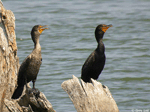 |
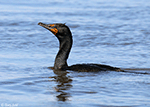 |
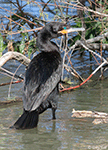 |
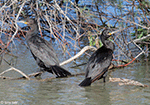 |
| Double-crested Cormorant | Double-crested Cormorant | Pelagic Cormorant | Pelagic Cormorant |
Conservation Status:
Populations of the Great Cormorant are very widespread across the Eastern Hemisphere, with indications that numbers are currently on the upswing. In North America, the range is much more limited along the Atlantic Coast, but systematic surveys there too show modest increases in numbers in the last few decades. Overall, global populations are found across an extremely broad geographic range, they are common in parts of that range, and overall populations are very strong. The IUCN lists the Great Cormorant as a species of "Least Concern."
Further Information:
Photo Information:
This (gorgeous!) photo taken by Andy Li - Licensed under Creative Commons Attribution NoDerivs Generic 2.0 License.
Audio File Credits:
- 1Jarek Matusiak . Recorded in Poland on February 17th, 2021. Original recording and information available from xeno-canto.
- 2Sean Ronayne. Recorded in Spain on January 5th, 2020. Original recording and information available from xeno-canto.
- 3Greg McLachlan. Recorded in Centennial Park in Sydney, Australia on July 29th, 2017. Original recording and information available from xeno-canto.
| Click below for a higher-resolution map |
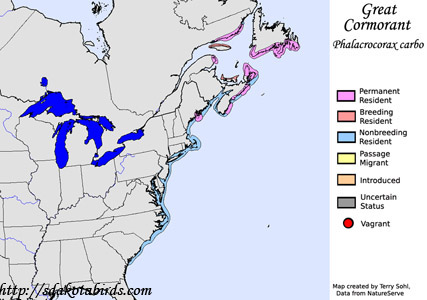 |
| South Dakota Status: Non-resident in South Dakota |
Additional Great Cormorant Photos
